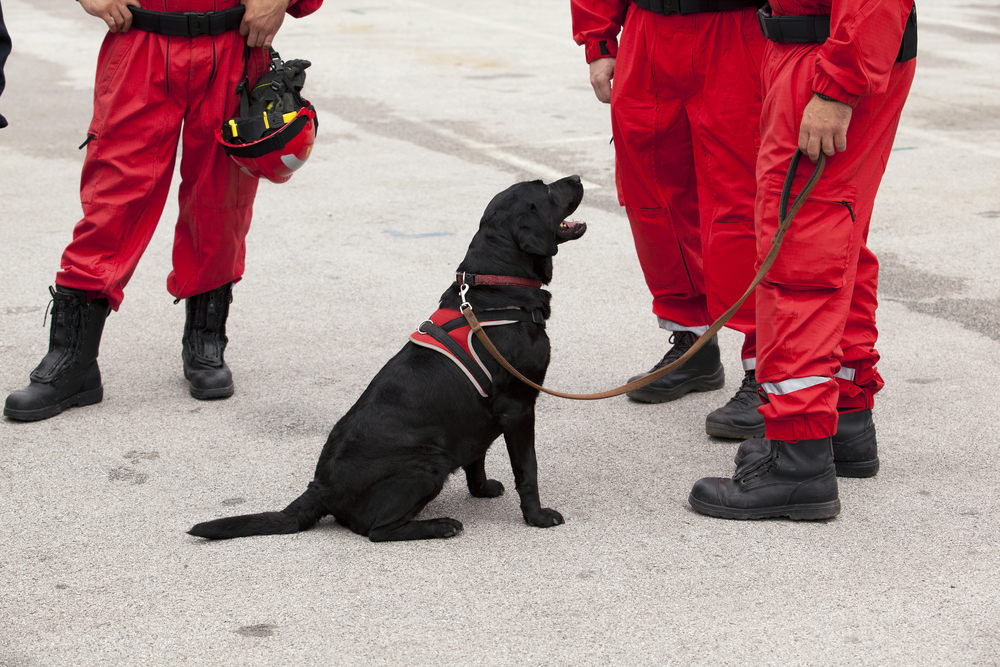On the Job: How Rescue Dogs Hunt for Tornado Survivors

In the aftermath of the devastating tornado that hit Moore, Okla., yesterday (May 20), search-and-rescue dogs are on the ground hunting for survivors amidst the rubble.
Oklahoma Gov. Mary Fallin announced at a news conference yesterday that rescue dogs had been deployed, the Wall Street Journal reported. These include a canine unit of five dogs from Texas Task Force 1.
Search-and-rescue dogs are often used in the wake of natural disasters to locate missing people. The dogs can be trained to search for trapped survivors or dead bodies; the canine units sent to Oklahoma include dogs trained to perform each of those tasks. [Image Gallery: Moore, Okla., Tornado Damage - May 20, 2013]
The human scent
To find people, the dogs rely on human scent. Scent molecules can be carried by skin cells known as skin rafts, which slough off at a rate of about 40,000 cells per minute; by human sweat; or by respiratory or decomposition gases.
The dogs deployed to sites of disasters like the Moore tornado are known as air-scenting dogs, because they survey scents carried through the air, as opposed to sniffing specific objects. The dogs are paired with handlers — usually volunteers — who train them.
The dogs are so valuable to rescue efforts because they can go into places people can't, said Dr. Deb Zoran, a veterinarian at Texas A&M University and the veterinary contact for Texas Task Force 1. The dogs wriggle into small spaces, explore unsafe buildings and climb through rubble. When they find something, they signal their handler with a bark, so the handler can alert a rescue crew.
Sign up for the Live Science daily newsletter now
Get the world’s most fascinating discoveries delivered straight to your inbox.
During deployments in-state, veterinarians like Zoran are on-site to provide medical care for the dogs, because just as humans working in hazardous environments face the risk of injury, rescue dogs can get hurt on the job. (Zoran and her team were not deployed to Oklahoma, however, because it was a federal, not state, response.) The dogs can injure themselves in a fall, or hurt their feet. And this time of year, it’s fairly hot in Oklahoma, so the dogs are at risk of heat stress. It's important to take care of the dogs so they can perform their duties, Zoran said.
The perfect rescue dog
Search-and-rescue dogs don't come from a single breed, but they are generally sporting dogs, such as Labradors or German shepherds. "Toy-obsessed” canines make the best search-and-rescue dogs, because a toy serves as the reward when the dogs find a person, Zoran said. (A small percentage of the dogs are motivated by treats instead of toys.) These have to be very driven and athletic dogs, Zoran said. They must be high-energy and prepared to go into dangerous situations, much as a fighter pilot must be, she said.
Typically, the dogs are selected when they're about 6 months old, and training takes 18 to 24 months. "It's a process of trial and error to find out if this is a dog that has the right stuff," Zoran said.
Above all, the dogs are motivated by the love of their work. When the dogs are at rest, they're turned off, Zoran said. "But when you bring them out, you can just see it — they are so ready," she said. "This is the greatest job ever, and they get the best reward ever."
Editor's Note: This article was updated on May 23, 2013, to note the correct number of Texas Task Force 1 dogs deployed to Moore, Okla. (five, not 12, as previously stated), and to clarify that the veterinarians who support the rescue dogs were not present in Moore because it was a federal response.
Follow Tanya Lewis on Twitter and Google+. Follow us @livescience, Facebook & Google+. Original article on LiveScience.com.










